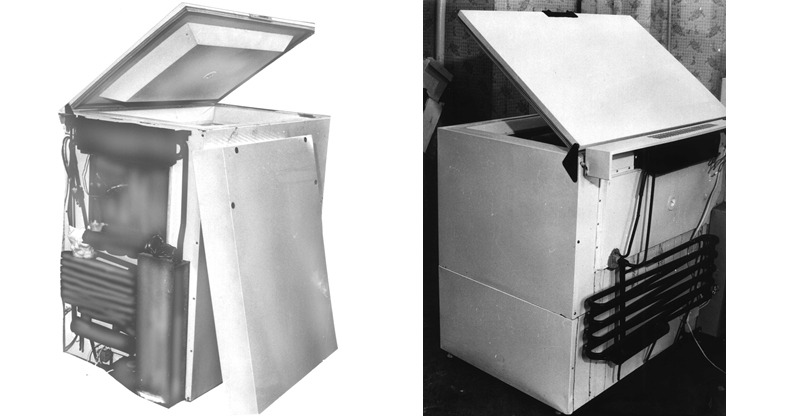Аналіз можливостей підвищення енергетичної ефективності абсорбційних холодильних приладів за рахунок використання холодоакумуляторів
DOI:
https://doi.org/10.15587/2706-5448.2023.286709Ключові слова:
навколишнє середовище, абсорбційний холодильний прилад, зниження дії на озоновий шар, абсорбційний морозильник, холодоакумулятор, енергетична ефективністьАнотація
Одним із найважливіших завдань сучасного суспільства є вирішення еколого-енергетичних проблем в енергомашинобудуванні та, зокрема, холодильній техніці. При цьому в галузі систем штучного охолодження необхідно вирішувати проблеми зниження впливу і на озоновий шар, і на ефект парнику. Ефективним підходом тут можуть бути абсорбційні холодильні системи з природним робочим тілом (водоаміачним розчином), яке не надає несприятливого впливу на навколишнє середовище. Для ефективного використання абсорбційних холодильних систем необхідно вирішувати завдання підвищення їхньої енергетичної ефективності, зокрема, за рахунок застосування холодоакумуляторів. Таким чином, об'єктом дослідження є системи охолодження абсорбційного типу із холодоакумуляторами.
У роботі проведено аналіз холодоакумуляторів із різною фізичною природою. Показано, що найбільш ефективними для вирішення задач низькотемпературного охолодження можуть бути речовини, що плавляться. Проведено аналіз теплової схеми абсорбційного морозильника типу «скриня», який є найбільш проблемним щодо забезпечення режимів охолодження на рівні (–18)–(–24) °С. Виконано оптимізаційні теплові розрахунки для типових абсорбційних морозильних камер об'ємом до 200 дм3. Показано, що при початковому завантаженні камери продуктом із температурою навколишнього середовища холодопродуктивності встановлених абсорбційних холодильних агрегатів недостатньо – не більше 50 % необхідної. Для абсорбційного морозильника типу «скриня» найбільш підходящими холодоакумулюючими матеріалами є евтектичний водний розчин хлориду натрію або пропіленгліколю, тому що ці розчини мають необхідну температуру плавлення порядку –18 °С і досить високу теплоту плавлення. Результатом оптимізації масогабаритних характеристик внутрішнього об'єму морозильної абсорбційної камери є наступні рекомендації:
– оптимальний розмір дротяних кошиків для розміщення продуктів становить 315´370´240 мм;
– зазори між кошиком та стінкою шафи, а також між самими кошиками має становити 10 мм для забезпечення нормальних умов конвекції;
– поміщати вентилятори всередині об'єму морозильної камери на даному етапі недоцільно, оскільки час заморожування знижується максимум на 30 %, але при цьому відбувається додаткові тепловиділення, витрати електроенергії та збільшується усушка продуктів, що зберігаються в камері.
Посилання
- Commission of the European DGXVII. The European renewable energy study. Office for Official Publications of the European Communities. Luxembourg, 1, 38.
- Consoli, F. (1993). Guidelines for life cycle assessment: A code of practice. Society of Environmental Toxicology and Chemistry workshop report. Sesimbra.
- Montreal Protocol on Substances That Deplete the Ozone Layer (1987). Final Act. UNEP, 6.
- McMullan, J. T. (2002). Refrigeration and the environment – issues and strategies for the future. International Journal of Refrigeration, 25 (1), 89–99. doi: https://doi.org/10.1016/s0140-7007(01)00007-x
- Bolina, B., Deesa, B. R., Iagera, Dzh., Uorrika, R. (1989). Parnikovyi effekt, izmenenie klimata i ekosistemy. Leningrad: Gidrometeoizdat, 558.
- DSTU 2295-93 (HOST 16317-95 ISO 5155-83, ISO 7371-85, IEC 335-2-24-84). Prylady kholodylni elektrychni pobutovi. Zahalni tekhnichni umovy (1996). Kyiv: Derzhstandart Ukrainy, 35.
- Zheleznyi, V. P., Khlieva, O. Ia., Bykovetc, N. P. (2001). Uchet emissii parnikovykh gazov pri formirovanii indikatorov dlia ekologo-energeticheskogo audita v kholodilnoi promyshlennosti. Ekotekhnologii i resursosberezhenie, 4, 51–58.
- Dincer, I., Ratlamwala, T. A. (2016). Developments in Absorption Refrigeration Systems. Integrated Absorption Refrigeration Systems Green Energy and Technology, 241–257. doi: https://doi.org/10.1007/978-3-319-33658-9_8
- Titlov, A. S. (1997). Sravnenie kharakteristik absorbtcionnoi i kompressionnoi bytovoi kholodilnoi tekhniki. Kholodilnaia tekhnika i tekhnologiia, 57, 39–41.
- Titlov, O. S., Vasyliv, O. B. (1998). Vartisni ta ekolohichni ekspluatatsiini kharakterystyky aparativ pobutovoi kholodylnoi tekhniky v Ukraini i krainakh YeES. Rynok instaliatsiinyi, 9, 18–20.
- Zolfagharkhani, S., Zamen, M., Shahmardan, M. M. (2018). Thermodynamic analysis and evaluation of a gas compression refrigeration cycle for fresh water production from atmospheric air. Energy Conversion and Management, 170, 97–107. doi: https://doi.org/10.1016/j.enconman.2018.05.016
- Babakyn, B. S., Vyhodyn, V. A. (1998). Bytovye kholodylnyky y morozylnyky. Moscow: Kolos, 631.
- Titlov, A. S., Zakharov, N. D. (2007). Sovremennyi uroven proizvodstva bytovykh absorbtcionnykh kholodilnykh priborov. Naukovі pratcі ONAKhT, 2 (31), 62–67.
- Titlov, A. S. (2008). Povyshenie energeticheskoi effektivnosti absorbtcionnykh kholodilnykh priborov. Naukovі pratcі ONAKhT, 1 (34), 295–303.
- Alekseev, V. A. (1975). Okhlazhdenie radioelektronnoi apparatury s ispolzovaniem plaviashchikhsia veshchestv. Moscow: Energiia, 88.
- Danilin, V. N. (1981). Fizicheskaia khimiia teplovykh akkumuliatorov. Krasnodar: Izd-vo Krasnodar. politekh. in-ta, 90.
- DSTU 3023-95 (HOST 30204-95, ISO 5155-83, ISO 7371-85, ISO 8187-91). Prylady kholodylni pobutovi. Ekspluatatsiini kharakterystyky ta metody vyprobuvan (1996). Kyiv: Derzhstandart Ukrainy, 22.
- Isachenko, V. P., Osipova, V. A., Sukomel, A. S. (1981). Teploperedacha. Moscow: Energiia, 416.
- Dulnev, G. N. (1984). Teplo- i massoobmen v radioelektronnoi apparature. Moscow: Vysshaia shkola, 247.
- Chumak, I. G., Nikulshina, D. G. (1988). Kholodilnye ustanovki. Proektirovanie. Kyiv: Vysshaia shkola, 280.
- Rodríguez-Muñoz, J. L., Belman-Flores, J. M. (2014). Review of diffusion–absorption refrigeration technologies. Renewable and Sustainable Energy Reviews, 30, 145–153. doi: https://doi.org/10.1016/j.rser.2013.09.019

##submission.downloads##
Опубліковано
Як цитувати
Номер
Розділ
Ліцензія
Авторське право (c) 2023 Liudmyla Berezovska, Oleksandr Titlov

Ця робота ліцензується відповідно до Creative Commons Attribution 4.0 International License.
Закріплення та умови передачі авторських прав (ідентифікація авторства) здійснюється у Ліцензійному договорі. Зокрема, автори залишають за собою право на авторство свого рукопису та передають журналу право першої публікації цієї роботи на умовах ліцензії Creative Commons CC BY. При цьому вони мають право укладати самостійно додаткові угоди, що стосуються неексклюзивного поширення роботи у тому вигляді, в якому вона була опублікована цим журналом, але за умови збереження посилання на першу публікацію статті в цьому журналі.








